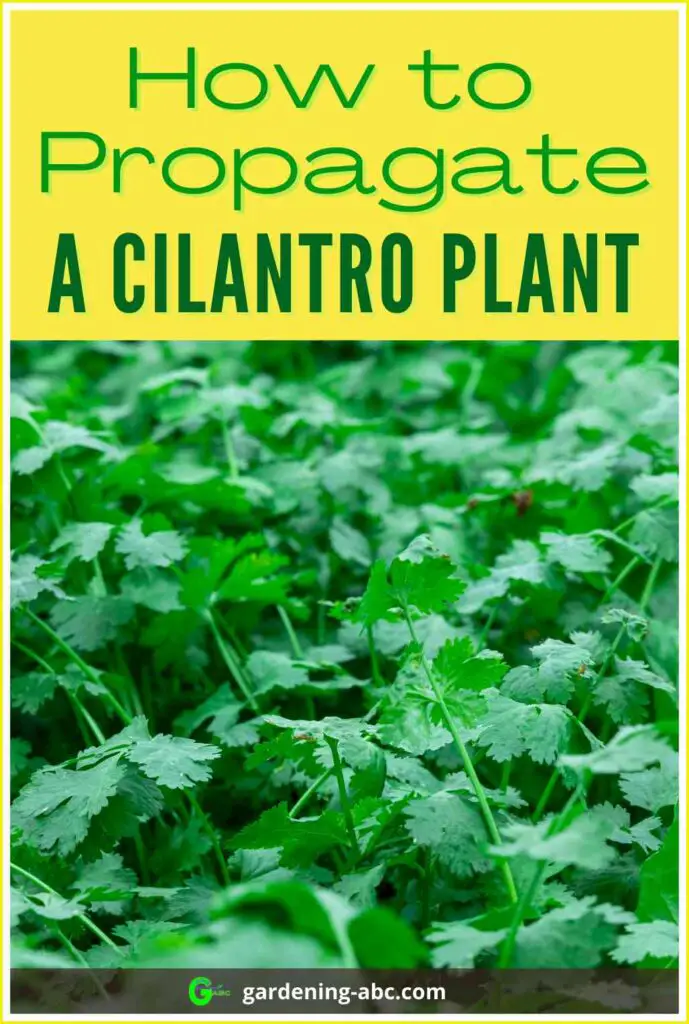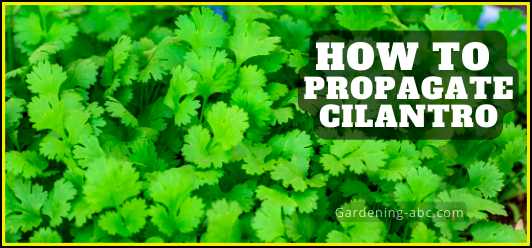We use affiliate links to run our site. When you buy through links on our site, we may earn an affiliate commission, without any added cost to you. Learn more
Cilantro is a popular herb in Mexican and South Asian cuisine. It’s also known as coriander and Chinese parsley.
Growing cilantro is the easiest way if you want a continuous fresh supply of leaves. If you have been trying to propagate cilantro but failed then this article will help you out, if you are just starting out with growing cilantro then this is what you need to do to get started.
With just a few leaves from your cilantro plant, you can grow new cilantro plants. You don’t have to buy more seeds or plants for additional cilantro. Just regrow the cilantro you already have.
More on how to regrow cilantro plants later but first…
How to Propagate A Cilantro Plant:
Cilantro can be propagated in two ways.
- Form the seeds,
- Regrow the existing cilantro
Propagating Cilantro Plants From The Seeds:
Cilantro is an annual herb that grows quickly in warm climates. The seeds are easy to grow and you can plant them in any season.
Unlike most plants, they don’t transplant too well. So the best way to grow cilantro from seeds is to sow them directly in a garden bed or a container.
Sow cilantro seeds directly into the garden once the soil has warmed up (at least 60 degrees F).
Space seeds about 1/2 inches apart and cover them with 1/2 inch of soil. Keep the soil moist but not soaked until germination occurs (about three days).
Once sprouts appear, thin to make room for healthy growth by pulling out any weak seedlings using tweezers or by cutting off their stems at ground level with scissors.
You can read more about growing cilantro from seeds here in this post.
Regrowing The Existing Cilantro Plant:
Re-growing your existing cilantro plants is actually quite easy. There are 3 ways to do that:
- Cutting down the main plant.
- Using cuttings from an existing plant.
- Using store bought cilantros
1. Cutting Down Cilantro:
Cilantro can be cut back at any time during its growth cycle to encourage new growth and maintain production. After the plant reaches more than 6 inches in height and you have completed your harvest, you can regrow that same plant once again.
At this time cut the stem with sharp scissors, or a garden pruner one inch above the soil. Don’t try to pull the plant so that its root system gets damaged.
after a few weeks, you will see new growth on this plant. this may not be as big as the earlier one but still, it can produce fresh cilantro for you.
2. Taking healthy cuttings from an Existing plant
If you have an established cilantro plant that has been producing well for several months, you can take healthy cuttings to start new plants.
Propagating cilantro from cuttings:
Propagation from cuttings is a common method used to grow most houseplants. And you can also propagate cilantro by this method.
Preparing cuttings is the process of cutting off part of a plant (usually a stem), and placing it into soil or water where it will develop roots and start growing.
Things you need:
Gather your supplies. You will need
- A sharp knife,
- potting soil,
- water and
- some containers to hold the cuttings.
If you are using pots already on hand in your garden or kitchen, make sure they have drainage holes in their bottoms so excess water does not drown the new plants.
You may also want to use some type of rooting hormone powder when making your cuttings to help them root faster.
Here is what you have to do:
Step 1: Select your cuttings:
The best time to collect cilantro cuttings is during spring or summer when new growth is developing rapidly.
Cut off a healthy stem about 6 inches long just below a node, where the leaves grow. A cutting should have at least two sets of leaves.
Remove any flowers that have formed so that energy can be directed towards root development instead (this will also prevent cross-pollination). Trim off all but the top set of leaves on each cutting,
Step 2: Grow roots on the cuttings:
Place your cutting into water immediately after harvesting it so that it doesn’t wilt while you prepare your potting mix and potting container for planting.
Take a small transparent container, put some water and keep the cutting in it. Keep the container in a place where it gets indirect sunlight and doesn’t get any direct sunlight. Remember as the cuttings are not yet ready, any direct sunlight will kill them.
Within a couple of weeks or two, you should see some root development on those cuttings.
Another way to grow roots on the cilantro cuttings is to dip the base in rooting hormone powder before planting it into a container filled with lightweight potting soil.
Step 3: Prepare soil for planting the cuttings:
Now prepare the ideal soil for planting those cuttings.
First, do a soil test where you want to plant the cuttings. If the soil lacks nutrients you may have to add compost and fertilizers.
So test also confirms the pH level. The ideal soil pH should be slightly acidic (6.2 to 6.8). If the pH is not in this range you may have to adjust it either by increasing the pH or by decreasing the pH.
Step 4: Plant the cuttings in the soil:
Once there are roots on your cutting, you can now plant them in the soil. You don’t need to plant the cuttings too deep in the soil or it might hurt the plant.
Keep the soil moist by regularly watering it. Make sure it doesn’t dry up completely.
You also have to ensure the cuttings are getting enough sunlight every day. If you don’t have ample sunlight use a simple grow light like this to grow the cuttings.
Step 5: Harvest you herbs:
Cilantro is a fast-growing herb and within 40-50 days they are ready to harvest. You can learn more about how to harvest cilantro so that it keeps on producing more leaves in this post.
Some Useful Tips on Taking Care of Your Cilantro Plants:
Here are some useful tips for growing cilantro from cutting:
- The health of the stem is crucial for growing cilantro from cuttings. If the stem is not sturdy or weak, the cutting will die within a few days and there will be no regrowth of the plant.
- Never put the cuttings too deep in water. only 2-3 inches is more than enough, otherwise the cutting will rot.
- Change the water every day, so that the water remains clean and are free from pests and pathogens.
- The cutting should not get any direct sunlight while they are still in the water. keep them at a place where they can get indirect sunlight.
- Treat soil soil with due importance. if the soil quality is not right the plant will not be able to survive.
- Keep the soil fertile by adding a nitrogen-based fertilizer like this, once or twice during the growing season.
- Water your plants regularly. And never make the soil dry out completely.
3. Regrow Your store-bought cilantro:
Finally, you can also regrow cilantro from your store-bought cilantro.
if the plants have existing roots cut the stem one inch above the roots and then plant those roots in small pots with moist potting soil.
If the plants don’t have roots in them pick the sturdiest ones and use them as cuttings to grow a new plant.
Conclusion:
Hopefully, with this post, you now have a better understanding of how to propagate and regrow cilantro plants.
If you have a nice big bunch of cilantro and you’re looking to save some money, propagate cilantro yourself. It’s easier than you think, with basic materials, and your plant will regrow for months. Give it a try!
If you found this post helpful share it with others. It’s surprising how little information is available on how to regrow and propagate cilantro at home. If you know someone who has a love of cilantro, this can make for a very welcome gift.
Don’t forget to PIN IT

Amazon and the Amazon logo are trademarks of Amazon.com, Inc, or its affiliates.

Hi there! My name is Prasenjit and I’m an avid gardener and someone who has grown a passion for growing plants. From my hands-on experience, I have learned what works and what doesn’t. Here I share everything I have learned.
